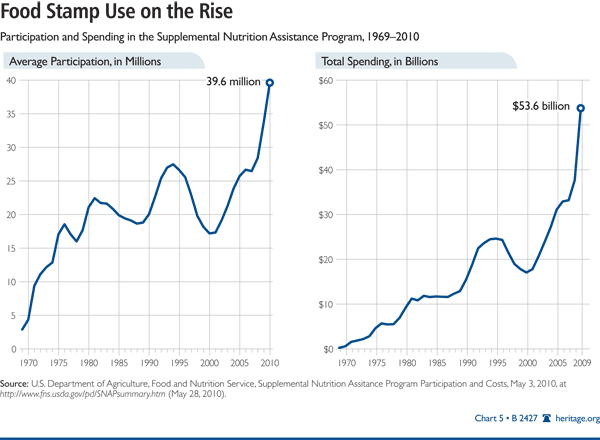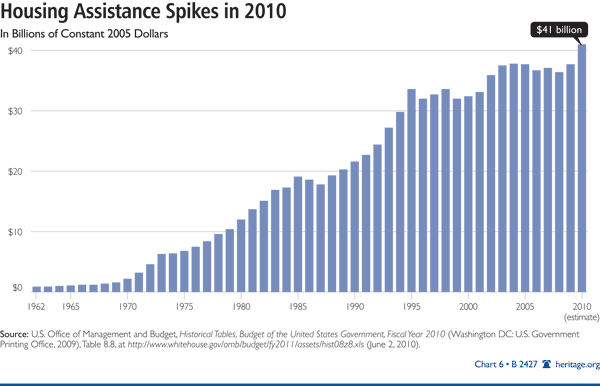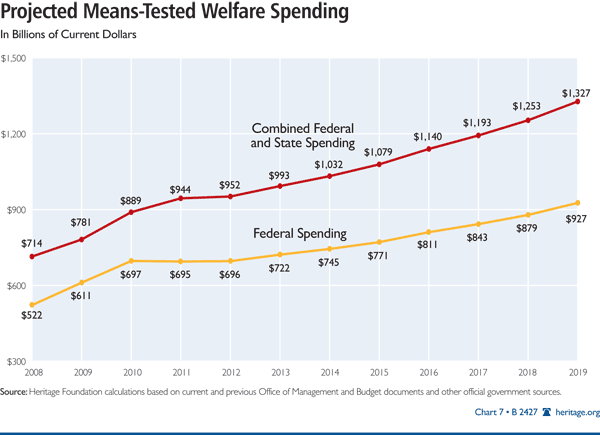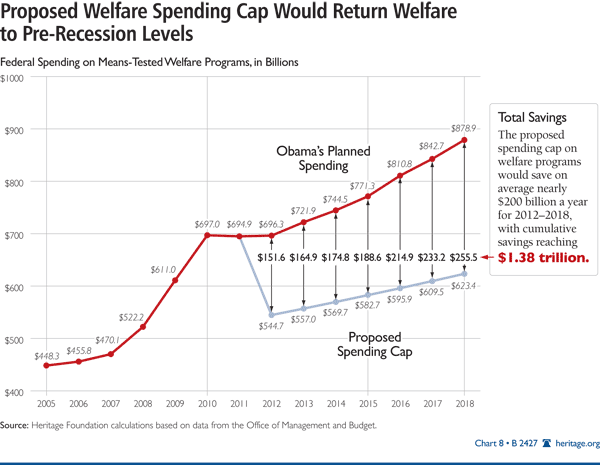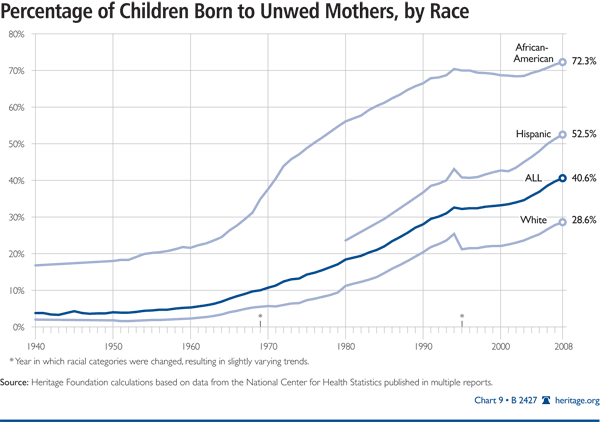Abstract: The growth of welfare spending is unsustainable and will drive the United States into bankruptcy if allowed to continue. President Barack Obama’s fiscal year 2011 budget request would increase total welfare spending to $953 billion—a 42 percent increase over welfare spending in FY 2008, the last full year of the Bush Administration. To bring welfare spending under control, Congress should reduce welfare spending to pre-recession levels after the recession ends and then limit future growth to the rate of inflation. Congress should also restore work requirements in the Temporary Assistance for Needy Families (TANF) program and apply them to other federal welfare programs.
Podcast: Listen to Katherine (Kiki) Bradley on slowing the growth of welfare.
The federal government runs over 70 different means-tested anti-poverty programs that provide cash, food, housing, medical care, and social services to poor and low-income persons. These means-tested programs—including food stamps, public housing, low-income energy assistance, and Medicaid—pay the bills and meet the physical needs of tens of millions of low-income families. However, these programs do not help the recipients move from a position of dependence on the government to being able to provide for themselves.
Only one welfare program, Temporary Assistance for Needy Families (TANF), promotes greater self-reliance. The reform that created TANF in the mid-1990s moved 2.8 million families off the welfare rolls and into jobs so that they were providing for themselves. Regrettably, while the TANF reform was successful, no other federal welfare programs have been reformed along similar lines. The TANF reform could serve as a partial model of reform for other programs for the poor.
As government spending on means-tested welfare approaches $1 trillion per year, it is time to reboot the other poverty programs to control costs and promote greater self-reliance. In addition, efforts to rebuild marriage in low-income communities would improve the well-being of children, parents, and communities.
Reform should be based on five principles:
- Slowing the growth of the welfare state. Unending government deficits are pushing the United States toward bankruptcy. The U.S. simply cannot afford the massive increases in welfare spending planned by President Barack Obama. Welfare spending is projected to cost taxpayers $10.3 trillion over the next 10 years.[1] Congress needs to establish reasonable fiscal constraints within the welfare system. Once the current recession ends, aggregate welfare spending should be rolled back to pre-recession levels. After this rollback has been completed, the growth of welfare spending should be capped at the rate of inflation.
- Promoting personal responsibility and work. Able-bodied welfare recipients should be required to work or to prepare for work as a condition of receiving aid. Food stamps and housing assistance, two of the largest programs for the needy, should be aligned with the TANF program to require able-bodied adults to work or to prepare for work for a minimum of 30 hours per week.
- Providing a portion of welfare assistance as loans rather than as grants. Welfare to able-bodied adults creates a potential moral hazard because providing assistance to those in need can lead to an increase in the behaviors that generate the need for aid in the first place. If welfare assistance rewards behaviors that lead to future dependence, costs can spiral out of control. A reformed welfare policy can provide temporary assistance to those in need while reducing the moral hazard associated with welfare by treating a portion of welfare aid as a loan to be repaid by able-bodied recipients rather than as an outright grant from the taxpayer.
-
Ending the welfare marriage penalty and encouraging marriage in low-income communities. The collapse of marriage is the major cause of child poverty in the U.S. today. When the War on Poverty began, 7 percent of children in the U.S. were born out of wedlock; today, the figure is over 40 percent.[2] Most alarmingly, the out-of-wedlock birthrate among African–Americans is 72 percent. The outcomes for children raised in single, never-married homes are greatly diminished.
Current means-tested welfare programs penalize low-income recipients who get married; these anti-marriage penalties should be reduced or eliminated. In addition, government should provide information on the importance of marriage to individuals in poor communities who have a high risk of having children out of wedlock. Particular emphasis should be placed on the benefits to children of a married two-parent family. -
Limit low-skill immigration. Around 15 percent ($100 billion per year) of total means-tested welfare spending goes to households headed by immigrants with high school degrees or less.[3] One-third of all immigrants lack a high school degree.[4] Over the next 10 years, America will spend $1.5 trillion on welfare benefits for lower-skill immigrants. Government policy should limit future immigration to those who will be net fiscal contributors, paying more in taxes than they receive in benefits. The legal immigration system should not encourage immigration of low-skill immigrants who would increase poverty in the nation and impose vast new costs on already overburdened taxpayers.
In addition, the government should not provide amnesty or “earned citizenship” to illegal immigrants, which would provide illegal immigrants with full access to the U.S. welfare system. Of the 11 million to 12 million illegal immigrants in the U.S., at least 50 percent lack a high school degree. Giving this population amnesty and access to welfare would lead to a staggering increase in future welfare costs.
Careful policy reforms focused on fiscal restraint, strong work requirements, the promotion of marriage, and personal responsibility can transform the federal welfare system, reducing dependence on government and increasing the well-being of families and children.
The Need for Reform
When President Lyndon Johnson announced the War on Poverty in 1964, he created large-scale national programs to help the poor and needy. Spending on these programs has grown to alarmingly high levels. In 1964, programs for the poor consumed 1.2 percent of the U.S. gross domestic product (GDP). Today, spending on welfare programs is 13 times greater than it was in 1964 and consumes over 5 percent of GDP. Spending per poor person in 2008 amounted to around $16,800 in programmatic benefits.
The Obama Administration has worked rapidly to expand the welfare state further. President Obama’s fiscal year (FY) 2011 budget would continue this trend, further increasing spending on programs for the poor to 42 percent above levels in FY 2008, President George W. Bush’s last full year in office. By 2011, total welfare spending (including the state portion) would rise to $953 billion.[5] (See Chart 1.)
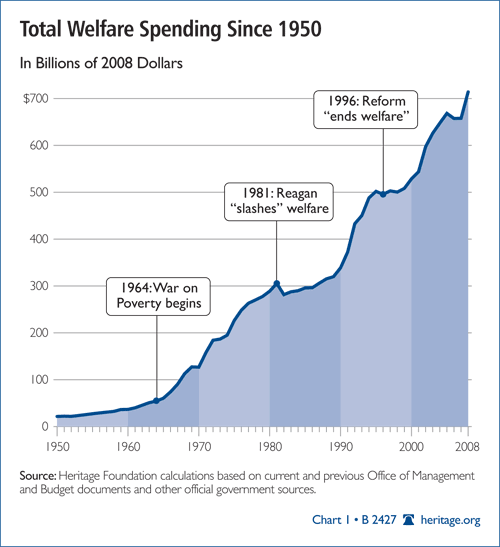
Critically, most of this increase represents a permanent expansion of the welfare state, not a temporary response to the current recession. According to President Obama’s published budget plans, welfare spending will not decline even after the current recession ends. Over the next 10 years, America will spend over $10.3 trillion on programs for the poor.[6] (See Chart 2.)
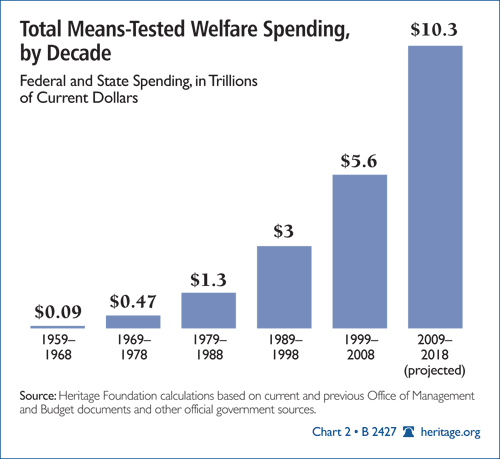
This massive, unending growth in welfare aid is not what President Johnson had in mind when he launched the War on Poverty in 1964. Johnson never intended to produce an ever-increasing system of government aid and a growing population that is dependent on the government. Instead, he actually sought to shrink the welfare state by curing causes of poverty. Rather than seeking to expand the welfare state, Johnson hoped to eliminate the future need for welfare by making the poor self-sufficient and prosperous.
Things did not work as President Johnson planned. Since the beginning of the War on Poverty, the U.S. has spent $15.9 trillion on means-tested welfare. Instead of reducing the causes of poverty, this spending has made the problem dramatically worse. By undermining intact families and eroding the work ethic in low-income communities, the welfare state has made families less capable of supporting themselves today than they were when the War on Poverty began.
For example:
- After adjusting for inflation, welfare spending is 13 times higher today than in 1965, when the War on Poverty started.
- The out-of-wedlock birthrate is 40 percent, and the African–American out-of-wedlock birthrate is 72 percent. When the War on Poverty began, the out-of-wedlock birthrate was 7 percent.[7]
- More than 40 million people are on food stamps. Four decades ago, only 4.3 million people were on the rolls.[8]
- As Chart 3 shows, means-tested welfare has grown faster than every other component of government over the past two decades. Welfare spending has grown more rapidly than Social Security and Medicare, education, and defense.
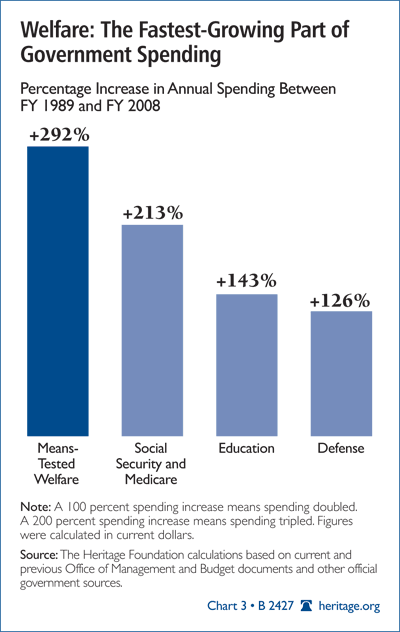
A Model of Partial Reform: The 1996 Welfare Reform Initiative
In 1996, the Aid to Families with Dependent Children (AFDC) program was transformed from a cash welfare program into a jobs program known as Temporary Assistance for Needy Families (TANF). Recipients were required to perform at least 20–30 hours per week of work or job preparation activities in exchange for the cash benefit.
Overnight, welfare agencies became job placement offices, and people who had been trapped in poverty and dependence began seeking employment. Between 1996 and 2009, caseloads dropped from 4.5 million families to 1.7 million. As the reform went into effect, employment for disadvantaged single mothers increased dramatically.[9]
The changes in AFDC were few, but they had a major impact on the program’s outcomes. First, the system for providing federal funds to the state governments was overhauled. Prior to reform, states were paid per person added to the AFDC rolls. This funding stream was eliminated and replaced with a fixed block grant. Under the new system, federal funding would no longer increase if states expanded their caseloads. Yet if caseloads fell, the state would no longer lose federal funds, but could keep the resultant savings and use them for other services for low-income persons chosen by the state. This simple fix shifted the mindset of state agencies from an emphasis on increasing enrollment and processing checks to a new focus on shrinking caseloads and increasing employment.
Work requirements also profoundly affected both the recipients and the states. States were required to have at least 40 percent of their adult TANF caseloads working or engaged in a work preparation activity. However, states were given credit toward meeting these participation rates if they succeeded in reducing their caseloads.[10] In the decades before welfare reform, state AFDC caseloads rarely if ever fell.
If state bureaucracies failed to meet their participation rates and failed to reduce caseloads, they faced a fiscal penalty. These incentives worked together to reduce unnecessary enrollments in welfare, drive caseloads down, and move as many recipients as possible into employment. The results were striking. Caseloads shrank by over 60 percent, 2.8 million families moved off the rolls and into jobs, and 1.6 million fewer children were left in poverty.[11]
The same principles that were effective in TANF could be applied to other federal means-tested programs. Many of these programs serve the same low-income population. The only real difference among them is the type of benefit offered: food, cash, or housing. Ending entitlement funding structures would be a good first step in slowing the growth of spending and stopping the practice of rewarding states for increasing their caseloads. Requiring beneficiaries in other programs to work or prepare for work as a condition of receiving aid would reduce dependence and increase employment.
Reforming Two of the Largest Federal Welfare Programs
Two of the largest federal welfare programs today are public housing assistance and food stamps (Supplemental Nutrition Assistance Program or SNAP). The federal government will spend nearly $107 billion on these two programs in 2010.
Food Stamps. SNAP is the federal government’s largest food assistance program. It is a quasi-entitlement that pays states for nearly every person who enrolls in the program. Benefits are mostly determined by the financial status of the household, including the value of any income and assets, and recipients are generally limited to those who are at or below 130 percent of the poverty line.
Although nearly all food stamp households contain working-age adults, few of these individuals are employed. The program fosters a pattern of long-term dependence. While the food stamp program is commonly misperceived as a temporary, short-term assistance program, in reality the majority of food stamp recipients at any given time are or will become long-term dependents. In fact, half of food stamp aid goes to individuals who have received aid for 8.5 years or more.[12] (See Chart 4.)
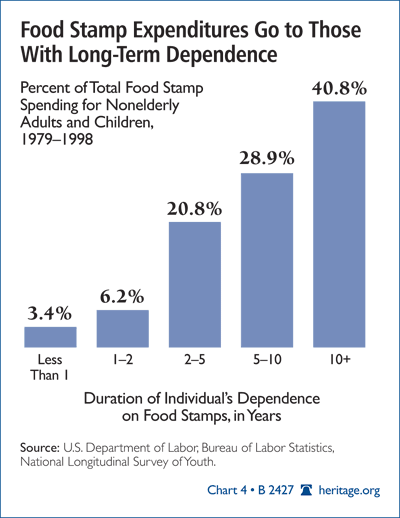
Over the life of the program, the number of recipients has grown steadily, and spending has skyrocketed over the past two years. The new enrollment numbers for February 2010 show that nearly 40 million people are receiving food stamps.[13] Spending on food stamps is expected to rise to $75 billion in 2011 according to the President’s budget for FY 2011. This is $36 billion more than in FY 2008. Enrollment has grown to 39 million people as of January 2010.[14]
To put the growth of this program into perspective, 31 million people were on the rolls in November 2008, and the program spent $39 billion in FY 2008. In contrast, since taking office, President Obama has almost doubled the spending on the program and added 8 million more people to the rolls. (See Chart 5.)
- The American Recovery and Reinvestment Act of 2009, the stimulus package, made several changes in the food stamp program, adding billions in spending and expanding eligibility to allow millions more people to qualify for the benefit. The maximum food stamp level was raised by 13 percent (about $44 a month for a three-person household). In addition, because of rising unemployment, the bill suspended the provision that requires able-bodied recipients without children to work at least half-time. This undoubtedly has added many more people to the rolls.
- The FY 2010 appropriations bill included a $5 billion funding increase over FY 2009 levels, but it also lifted the cap on spending altogether. A little-known provision in the FY 2010 defense appropriations bill allows elevating SNAP’s annual funding to “such sums as necessary” in emergency cases where annual appropriations may be too low.[15] It could be argued that the current hard economic times could be deemed an “emergency,” thus allowing the federal government to spend billions more on food stamps.
- Finally, the President’s FY 2011 budget would continue to expand the program and further increase funding. The budget assumes outlays of $75 billion for FY 2011, which is $36 billion more than outlays in FY 2008. The President also asks to extend the new entitlement authority under the FY 2010 defense appropriations bill and suspend the work requirement for another year. The budget would also greatly expand eligibility by increasing the asset test from $2,000 to $10,000 and by not counting refundable tax credits as income.[16] This would make many more people eligible for food stamps.
Although some increase in food stamp spending is reasonable during a recession, food stamp spending has increased steadily for more than a decade. This long-term growth in spending cannot be sustained in the environment of perpetual budget deficits and soaring national debt. Food stamp reform should center on two major points: controlling spending and instilling real work requirements.
Public Housing. The U.S. Department of Housing and Urban Development (HUD) runs three primary housing programs that provide assistance to low-income citizens: the public housing program (through the Operating Fund and the Capital Fund); Section 8 Project Based Assistance; and Section 8 Housing Choice Vouchers. Under the President’s budget, total estimated spending will be $37 billion in FY 2011. These programs subsidize the rent of about 4 million low-income households annually. According to the Office of Management and Budget, housing assistance programs are scheduled to spend $235 billion overall over the next five years.
Each of these programs is run through quasi-governmental agencies at the local level, known as Public Housing Authorities (PHAs). The approximately 4,200 PHAs around the country manage, operate, and generally oversee the administrative functions of federally funded public housing. Although the programs differ slightly, they all serve basically the same population of low-income people. In general, eligibility is limited to those with incomes at or less than 80 percent or 50 percent of the median income average for their county or metropolitan areas. Tenants pay approximately 30 percent of their income toward the rent, while the government covers the balance.
Because no time limits or work requirements are associated with any of these programs, recipients have no incentive or urgency to find employment or leave the rolls. A HUD study done in 2007 found that public housing recipients spend twice as many years as voucher recipients in the program with an average of 7.46 years.[17] The same study showed that 28 percent of public housing recipients and 14 percent of voucher recipients spent more than 10 years in the program. When elderly and disabled recipients are excluded, households of able-bodied recipients without children spent an average of 7.9 years in public housing compared with 4.2 years for those with children. These numbers are significantly lower for the same families receiving vouchers at 3.5 years and 3.4 years, respectively.[18]
Public Housing Operating Fund and Capital Fund. Both of these funds send money to the PHAs to pay the operating and management costs of public housing. The FY 2011 budget estimates $9 billion in spending for these public housing structures and units, which received an added boost of $4 billion in the 2009 stimulus package. These funds reportedly are going toward capital needs as well as to “support energy efficient, green communities.”[19] Overall, about 1.2 million households live in these public housing units.
Section 8 Project Based Housing. Begun in 1974, this form of public housing currently serves about 1 million households and is on a trajectory to spend $8.7 billion in 2011. The PHAs enter into contracts with owners of privately owned buildings to subsidize a certain number of units that are offered to families at a reduced rent according to their incomes. In the 1980s, the program came under criticism for costing too much and limiting recipients to living in communities with high poverty. As a result, Congress ended the funding of new contracts and pivoted toward a new program concept of providing families with vouchers to enable them to find their own housing.[20] The 1 million units currently funded are based on original contracts and renewals.
Section 8 Housing Choice Vouchers. The largest federal housing program, Section 8 Housing Choice Vouchers, is run through HUD’s tenant-based rental assistance account. Low-income to very low-income families are given vouchers to use in the private housing market to subsidize their rent. About 2 million households receive vouchers. Funding for the Section 8 Housing Choice Voucher program has increased continually over the past decade. President Obama’s FY 2011 budget would increase funding by more than $3 billion from $15.7 billion in FY 2011 to $19.1 billion.
Strategies for Reform
Welfare reform should include at least five components: controlling welfare spending, instilling a discipline of work among welfare recipients, reducing rewards for dependence on welfare by treating a portion of the aid as a loan, promoting healthy marriage as the best way to prevent poverty, and limiting immigration of low-skill immigrants.
Controlling Spending. When Lyndon Johnson declared a War on Poverty in 1964, welfare spending consumed 1.2 percent of GDP. Today, welfare spending has risen to nearly 6 percent of GDP, and President Obama is rapidly increasing spending and eligibility for means-tested programs. Under his FY 2011 budget, spending on welfare programs would grow to 42 percent above the level of welfare spending during President Bush’s last full year in office (FY 2008). By 2012, annual means-tested spending (including state spending) will rise to $953 billion.
Critically, most of Obama’s spending increases are permanent expansions of the welfare state, not short-term responses to the current recession. (See Chart 7.) According to Obama’s published budget plans, means-tested welfare spending over the next decade will total $10.3 trillion, not including spending for Obamacare.[21] Most of this welfare spendathon will be financed by borrowing from future generations. Not surprisingly, the federal debt will grow to equal nearly the entire national economy by the end of the decade.
This endless spending growth is unsustainable and will drive the nation into bankruptcy. Congress must return to a reasonable fiscal path. To accomplish this, once the current recession ends, Congress should return aggregate federal means-tested welfare spending to the pre-recession level, which was already a historic high at the time. Then Congress should cap total spending growth in the more than 70 federal welfare programs at the inflation rate. As Chart 8 shows, this cap would save $1.4 trillion over the next 10 years. Within this overall limit on welfare spending, funding for individual programs could be increased or decreased, depending on changing priorities and program effectiveness.
Instilling a Discipline of Work. One of the most important elements of TANF reform that led to success was the addition of meaningful work requirements. This was at the core of helping to move families off of welfare and into jobs. States were required to reduce caseloads, to have at least 40 percent of their adult population engaged in some kind of work or job preparation activity, or some combination of the two. States that failed to reduce dependence or require a sufficient portion of their TANF rolls to engage in work-related activities faced fiscal penalties. As a result of these provisions, the caseload nationally fell by more than 60 percent in only a few years. More than 2.8 million families left welfare for jobs and a better life.
Both food stamps and the three major federal housing programs could easily be reformed along the same lines by adding similar work requirements. Often, families will receive benefits simultaneously from several programs. Benefits from multiple programs should be tied together as a package, and the beneficiary should be required to work or prepare for work as a condition of receiving the entire package of aid. There is no reason why TANF should have a work requirement while the other welfare programs are treated like old-style entitlements.
Work requirements should have “teeth” and consequences for nonparticipation. For instance, if an able-bodied recipient refuses to participate in work or work preparation activities for at least 30 hours a week, then that recipient should lose the benefits. TANF studies have shown that states that implement these kinds of sanction policies see an immediate change to behaviors that lead to greater compliance and increased self-sufficiency.
In addition to adding work requirements to food stamps and housing, the TANF program should be restored to its original format. President Obama and Congress undermined TANF’s work and funding structure by creating a $5 billion TANF Emergency Fund in the 2009 stimulus package.[22] The fund essentially pays states for increasing their caseloads while putting little to no emphasis on work strategies. In fact, only 16 percent of spending from this fund has gone toward any kind of employment or welfare-to-work programming.[23] The Welfare Reform Restoration Act of 2009 (H.R. 1277), introduced by Representative Tom Price (R–GA), would repeal this fund.
Reducing Rewards for Dependence. The United States funds a system of welfare entitlements that is far larger than most people imagine. This year, federal and state governments will spend nearly $900 billion on means-tested benefits for poor and low-income persons. This high level of spending is not a short-term response to the current recession, but the result of the steady long-term growth of the welfare state. According to President Obama’s budget, means-tested spending will not decline substantially even after the recession ends.
Roughly half of means-tested aid goes to persons who are disabled or to poor elderly persons in nursing homes. The other half goes largely to able-bodied parents and their children. This spending amounts to over $25,000 for each family with children in the lowest-income third of the U.S. population.
Welfare entitlements generally begin at a child’s birth. Some 40 percent of all births in the U.S. are now paid for by the Medicaid program. Most of these Medicaid-funded births occur to never-married women with low education levels. Once the taxpayer has paid for the childbirth, aid to the mother and child will generally continue through a wide variety of programs for years to come. Most of this aid takes the form of unconditional welfare assistance in which the taxpayer is required to support the recipient but the recipient is required to do little or nothing in exchange for the aid. In particular, the potential recipient is never expected to take reasonable steps to avoid future dependence.
Government welfare assistance to disabled persons and to the indigent elderly is nonproblematic and has widespread public support. Means-tested assistance to able-bodied parents and their children is more problematic, but simply abolishing it is neither feasible nor desirable. Government should continue to provide assistance to parents and their children when they are in need. However, the current incentive structure of this assistance is unsustainable because it rewards and sustains behavior that leads to even greater levels of dependence in future years.
Poverty and welfare dependence among able-bodied adults is largely the result of counterproductive and self-limiting behaviors: dropping out of school, having children outside of marriage, and intermittent, haphazard employment. Particularly important is the widespread nonmarital childbearing that pervades most low-income communities. Out-of-wedlock childbearing and single parenthood form the foundation of most child poverty and welfare dependence in American society.
Because the welfare state buffers individuals from the financial consequences of poor decisions and self-destructive behaviors, it encourages and perpetuates these behaviors. Welfare must be revolutionized to increase the incentives for constructive behaviors while limiting the rewards for behaviors that generate poverty and dependence.
One way to alter the welfare incentive system is to make potential welfare recipients more aware of and responsible for the financial costs resulting from imprudent decisions and behaviors. To accomplish this, government could treat the means-tested cash, food, housing, and medical care received by able-bodied parents and their children as a loan. The parent could be expected to repay some portion of the loan (perhaps one-third) at some future time. Both custodial and noncustodial parents would bear some responsibility for the welfare costs of their children.
Treating welfare as a partial loan would ensure that families would continue to receive assistance when in need but would also reduce the incentives for dependence-producing behaviors in the future. If such a policy were implemented throughout the welfare system, over the long term it could reduce the high levels of early nonmarital childbearing that are a predominant cause of poverty and dependence in American society.
Promoting Healthy Marriage. The decline of marriage is a predominant cause of child poverty. Roughly two-thirds of poor children reside in single-parent homes. Children born to and raised by a single parent are seven times more likely to live in poverty than children born to and raised by a married couple.
The lack of marriage is also a huge contributor to welfare dependence and massive government spending. Government spends over $250 billion annually on welfare benefits for single-parent homes in the form of health care, day care, education, food, housing, and other assistance. Restoring marriage in low-income communities has the potential to reduce long-term welfare costs significantly. If poor women who have children out of wedlock were married to the actual fathers of their children, nearly two-thirds would immediately be lifted out of poverty.[24]
Government can take two important first steps to encourage marriage in low-income communities. First, Congress should reduce the marriage penalty inherent in means-tested welfare programs. Second, the government should provide information on the benefits of marriage in low-income communities with high rates of out-of-wedlock childbearing. (See Chart 9.)
Eliminating the Marriage Penalties. As noted, the federal government operates over 70 means-tested welfare programs. Nearly all of these programs work on a simple accounting principle: The less income a family earns, the greater the benefits it will receive from the government.
In many cases, the earnings of an employed husband will be sufficient to bar a family from welfare aid. Therefore, the first rule for maximizing welfare aid is for the mother not to be married to the father of her children, especially if the father has a job. This creates an unfortunate social paradox: Many low-income couples can maximize their joint earnings by avoiding marriage. If the couple is unmarried, the mother will likely receive welfare income and benefits while the father will have any income from his job. If the couple marries, much or all of the welfare aid will be lost, and only the father’s earnings will remain. In the crazy world of welfare, marriage reduces a couple’s joint income while remaining single increases it.
These incentives are clearly counterproductive. The marriage penalties built into means-tested programs should be eliminated or at least reduced. However, reducing the marriage penalties in each of the more than 70 individual programs would be administratively infeasible. A simpler approach would be to increase the earned income tax credit for married families with children to offset the marriage penalties in other welfare programs.
Providing Information on the Importance of Marriage. In most respects, children raised by their married biological parents are far better off than children raised in broken homes. It is in the best interest of children, parents, and society to encourage women to delay childbirth until they are economically secure and in a stable marital relationship. These two conditions are tightly interrelated because marriage is a potent factor in creating economic security and stability. Research shows that most low-income parents are not hostile to marriage, but they no longer believe it is important to be married before bringing children into the world. This serious misconception leads to disastrous long-term consequences for children, parents, and society.
In the interest of restraining welfare costs and improving life outcomes for children, government should inform potential parents in low-income communities of the benefits of marriage and educate those who are interested in the steps to prepare for and maintain a healthy marriage. To accomplish this, government should:
- Conduct public education campaigns within low-income communities on the importance of marriage;
- Provide marriage education classes to at-risk students in middle and high schools; and
- Provide life skills training, relationship building, and marriage education programs to interested young adults who are likely to become single parents.
Some fiscal conservatives may object to such government activism, but unless marriage is restored in low-income communities, there is little hope of slowing the growth of the welfare state.
Limiting Low-Skill Immigration. Current immigration policies encourage a disproportionate number of poorly educated immigrants to enter the United States. In fact, one-third of current immigrants lack a high school degree.[25]
Most lawful low-skill immigrants gain permanent residence through kinship preferences within the legal immigration law. These preferences for their adult brothers, sisters, and parents tend to bring large numbers of low-skill immigrants into the U.S., increasing the fiscal strain on taxpayers. The system should be reformed to allow entry for only spouses and children.
About 15 percent of all welfare spending ($100 billion per year) goes to households headed by lower-skill immigrants who have a high school– level education or less. Assuming the ratio remains constant for the next decade, America will spend $1.5 trillion in welfare benefits on lower-skill immigrants.[26]
This number is low compared to the trillions that would be spent if the current 11 million to 12 million illegal immigrants already residing in the U.S. were given amnesty. Less than 50 percent of them have high school degrees. Amnesty would make this population eligible for means-tested welfare as well as other government benefits. The cost to taxpayers would be devastating: Social Security and Medicare costs alone would be $2.6 trillion.[27]
As the education level of native-born U.S. citizens gradually rises, there is a tendency, ceteris paribus, for welfare dependence to decline. However, massive low-skill immigration works in the opposite direction, replenishing welfare rolls and adding to costs. In addition, high levels of low-skill immigration tend to suppress the wages of less-skilled American workers, thereby adding to welfare costs within that group.[28]
The legal immigration system should be reformed to limit immigration of low-skill immigrants who would impose a fiscal burden on the U.S. taxpayer and to increase the number of higher-skill immigrants who would pay more in taxes than they would receive in benefits.
Conclusion
The means-tested welfare system consists of over 70 programs providing cash, food, housing, medical care, and social services to poor and low-income persons. Even before the current recession, welfare spending was at record levels and growing rapidly. Over the next decade, the U.S. will spend more than $10.3 trillion on means-tested welfare. This amounts to around $100,000 for each person in the lowest-income third of the population.
The continuing rapid growth of welfare spending is unsustainable. The U.S. can no longer afford the automatic and unlimited growth of welfare entitlements. Once the current recession ends, total federal welfare spending should be returned to pre-recession levels, and future growth should be subject to fixed spending limits.
In addition, careful attention must be paid to the underlying causes of poverty and welfare dependence. Welfare has grown rapidly, in part, because the government has rewarded and encouraged conditions that lead to dependence. In particular, the decline in marriage, chronic low levels of work among the poor, and the immigration of millions of persons without a high school degree are major factors leading to high levels of poverty and a burgeoning welfare state.
In the future, government policy should encourage constructive behaviors leading to self-reliance and prosperity rather than rewarding counterproductive behaviors leading to costly dependence and poverty.
—Katherine Bradley is Visiting Fellow in the Richard and Helen DeVos Center for Religion and Civil Society, and Robert Rector is Senior Research Fellow in the Domestic Policy Studies Department, at The Heritage Foundation.

